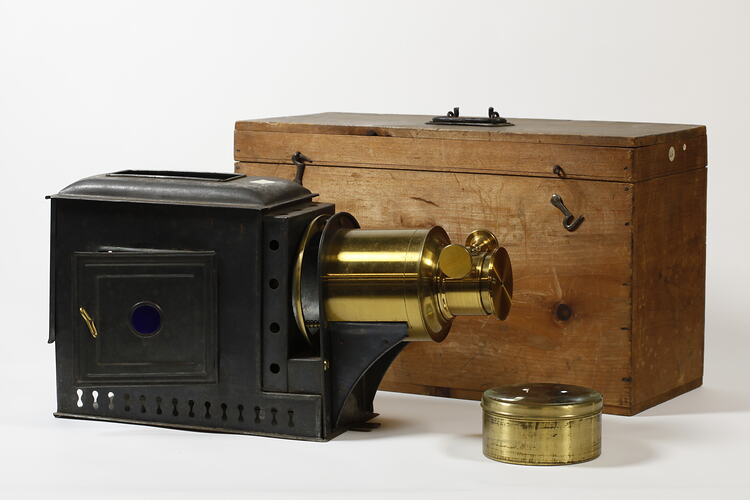Summary
Metal projector used to view lantern slides. It is by an unknown manufacturer. It comes complete with a wooden carry box.
While the invention of the magic lantern is generally seen to be in the 17th century, its greatest popularity as an optical projector spans the late 18th century to the early decades of the 20th century. It was used both as a means of entertainment and education.
This lantern projector is part of the Francis Collection of pre-cinematic apparatus and ephemera, acquired by the Australian and Victorian Governments in 1975. David Francis was the curator of the National Film and Sound Archive of the British Film Institute as well as being a co-founder of the Museum of the Moving Image in London, which was operational between 1988 and 1999.
Physical Description
Rectangular wooden box with hinged top lid. Two hasp closure. Black metal lantern projector. Roof has rectangular aperture for chimney/cowl (missing). Brass lens tube with rack and pinion focus. Brass lens swivel cover. Circular cutouts along outer body over condenser housing. Along bottom of each lateral side decorative die cut ventilation holes to illumination chamber. Right lateral side of lantern body has side-hinged door to illumination chamber with circular blue glass peep hole. Brass coloured wing handle to door. At back of lantern body top hinged 3/4 door to illumination chamber. Interior of illumination chamber has slides at each lateral side for illuminant. Condenser insitu.
More Information
-
Collection Names
-
Collecting Areas
-
Acquisition Information
Loan & Subsequent Donation from Australian Film Institute (AFI), Mr David Francis, by Nov 1990
-
Collector
Mr David Francis, London, Middlesex, England, Great Britain, 1990
-
Date Made
-
Inscriptions
On rectangular paper sticker on roof of lantern: 'C' On rectangular piece of paper found within lantern illumination chamber, handwritten: 'No 16/Iron and brass. Requires paraffin/burner. Restore for sale/or break' On circular sticker on right lateral side of box: '460' On circular sticker on right lateral side of box, handwritten: '16'
-
Classification
Communications, Audio-visual technology, Image projection equipment
-
Category
-
Discipline
-
Type of item
-
Overall Dimensions
425 mm (Length), 135 mm (Width), 230 mm (Height)
-
Keywords
Lantern Projectors, Magic Lanterns, Pre-Cinema Moving Images, Projectors



